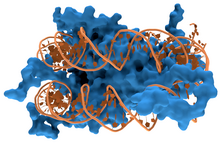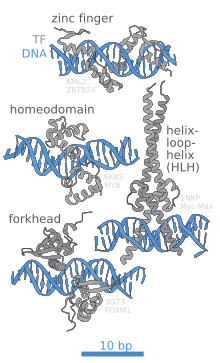DNA-binding protein




DNA-binding proteins are
Examples
DNA-binding
Non-specific DNA-protein interactions
Structural proteins that bind DNA are well-understood examples of non-specific DNA-protein interactions. Within chromosomes, DNA is held in complexes with structural proteins. These proteins organize the DNA into a compact structure called
Proteins that specifically bind single-stranded DNA
A distinct group of DNA-binding proteins are the DNA-binding proteins that specifically bind single-stranded DNA. In humans, replication protein A is the best-understood member of this family and is used in processes where the double helix is separated, including DNA replication, recombination and DNA repair.[18] These binding proteins seem to stabilize single-stranded DNA and protect it from forming stem-loops or being degraded by nucleases.
Binding to specific DNA sequences

In contrast, other proteins have evolved to bind to specific DNA sequences. The most intensively studied of these are the various transcription factors, which are proteins that regulate transcription. Each transcription factor binds to one specific set of DNA sequences and activates or inhibits the transcription of genes that have these sequences near their promoters. The transcription factors do this in two ways. Firstly, they can bind the RNA polymerase responsible for transcription, either directly or through other mediator proteins; this locates the polymerase at the promoter and allows it to begin transcription.[19] Alternatively, transcription factors can bind enzymes that modify the histones at the promoter. This alters the accessibility of the DNA template to the polymerase.[20]
These DNA targets can occur throughout an organism's genome. Thus, changes in the activity of one type of transcription factor can affect thousands of genes.[21] Thus, these proteins are often the targets of the signal transduction processes that control responses to environmental changes or cellular differentiation and development. The specificity of these transcription factors' interactions with DNA come from the proteins making multiple contacts to the edges of the DNA bases, allowing them to read the DNA sequence. Most of these base-interactions are made in the major groove, where the bases are most accessible.[22] Mathematical descriptions of protein-DNA binding taking into account sequence-specificity, and competitive and cooperative binding of proteins of different types are usually performed with the help of the lattice models.[23] Computational methods to identify the DNA binding sequence specificity have been proposed to make a good use of the abundant sequence data in the post-genomic era.[24]
Protein–DNA interactions
Protein–DNA interactions occur when a
In general, proteins bind to DNA in the
Design
Designing DNA-binding proteins that have a specified DNA-binding site has been an important goal for biotechnology.
Detection methods
There are many in vitro and in vivo techniques which are useful in detecting DNA-Protein Interactions. The following lists some methods currently in use:
Manipulating the interactions
The protein–DNA interactions can be modulated using stimuli like ionic strength of the buffer, macromolecular crowding,[26] temperature, pH and electric field. This can lead to reversible dissociation/association of the protein–DNA complex.[36][37]
See also
- bZIP domain
- ChIP-exo
- Comparison of nucleic acid simulation software
- DNA-binding domain
- Helix-loop-helix
- Helix-turn-helix
- HMG-box
- Leucine zipper
- Lexitropsin (a semi-synthetic DNA-binding ligand)
- Deoxyribonucleoprotein
- Protein–DNA interaction site prediction software
- RNA-binding protein
- Single-strand binding protein
- Zinc finger
References
- ^ Created from PDB 1LMB
- ^ Created from PDB 1RVA
- ISBN 978-0-412-25990-6.
- PMID 6236744.
- .
- PMID 2422697.
- PMID 2421408.
- S2CID 21101836.
- PMID 15853876.
- S2CID 4328827.
- S2CID 1883924.
- )
- PMID 11497996.
- PMID 25063301.
- PMID 28303166.
- PMID 8178371.
- PMID 26762975.
- PMID 10473346.
- PMID 10966474.
- S2CID 14668705.
- PMID 12808131.
- PMID 6236744.
- S2CID 103345.
- PMID 23814189.
- PMID 9646864.
- ^ PMID 27471033.
- PMID 21929364.
- S2CID 310256.
- PMID 6275366.
- PMID 6269071.
- PMID 21108821.
- PMID 27557760.
- PMID 26025051.
- PMID 24146751.
- PMID 212715.
- .
- PMID 27874042.
External links
- Protein-DNA binding: data, tools & models (annotated list, constantly updated)
- Abalone tool for modeling DNA-ligand interactions.
- DBD database of predicted transcription factors Uses a curated set of DNA-binding domains to predict transcription factors in all completely sequenced genomes
- DNA-Binding+Proteins at the U.S. National Library of Medicine Medical Subject Headings (MeSH)
